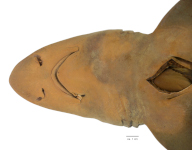Mustelus minicanis
Heemstra, 1997
Classification: Elasmobranchii Carcharhiniformes Triakidae
Reference of the original description
A Review of the Smooth-Hound Sharks (Genus Mustelus, Family Triakidae) of the Western Atlantic Ocean, with Descriptions of Two New Species and a New Subspecies. Bulletin of Marine Science, 60(3), 894–928
A Review of the Smooth-Hound Sharks (Genus Mustelus, Family Triakidae) of the Western Atlantic Ocean, with Descriptions of Two New Species and a New Subspecies. Bulletin of Marine Science, 60(3), 894–928
Image of the original description
Image in copyright.
Image in copyright.
Types
Mustelus minicanis
Holotype: USNM: 207961; Paratype: ANSP: 120342; UF: 19140; UF: 230376 (old: UMML 30376); USNM: 208017; USNM: 207962; USNM: 208016;
Mustelus minicanis
Holotype: USNM: 207961; Paratype: ANSP: 120342; UF: 19140; UF: 230376 (old: UMML 30376); USNM: 208017; USNM: 207962; USNM: 208016;
Description :
Citation: Mustelus minicanis Heemstra, 1997: In: Database of modern sharks, rays and chimaeras, www.shark-references.com, World Wide Web electronic publication, Version 12/2025
Please send your images of "Mustelus minicanis" to info@shark-references.com

Mustelus minicanis Heemstra, 1997, ANSP 120342, paratype, 57 cm TL © Mark Sabaj Perez

Mustelus minicanis Heemstra, 1997, ANSP 120342, paratype, 57 cm TL © Mark Sabaj Perez
Short Description
Diagnosis after Heemstra, 1997 [1103]: Ventral lobe of caudal fin not well developed; the ventral lobe angle obtuse (129°-163°). Trailing edges of dorsal fins not frayed. Rear (distal) edge of pectoral and pelvic fins slightly concave. Head moderate, pre-pectoral distance 18-21% TL; inter-orbital distance 4.2- 4.8% TL; pre-oral snout length 6.1-7.3% TL; inter-nostril distance 2.7-3.1 % TL; eye large, orbit diameter 3.2-4.3% TL. Upper-jaw labial folds 1.3-1.7% TL, slightly longer than lower-jaw folds. Teeth wide, asymmetric, with a low rounded cusp and prominent basal ridges (Fig. 11); tooth width about 3 times crown height; tooth counts 60-67/60-61. Denticles lanceolate and/or tridentate with four ridges extending to rear margin of scale. Buccopharyngeal denticles (Fig. 180) confined to a triangular patch at front of palate, front and rear sides of gill arches, posterior margin of pharyngeal pads on fifth gill arch, and a triangular patch at tip of tongue. Upper jaw skeleton comprises a single cartilage on each side. Spiral valve of intestine with seven turns. Diagnostic vertebral numbers are given in Figures 23-25. Head and body immaculate grey dorsally; newborn young and juveniles with sooty smudges on apices of dorsal fins and tip of caudal fin.
Diagnosis after Heemstra, 1997 [1103]: Ventral lobe of caudal fin not well developed; the ventral lobe angle obtuse (129°-163°). Trailing edges of dorsal fins not frayed. Rear (distal) edge of pectoral and pelvic fins slightly concave. Head moderate, pre-pectoral distance 18-21% TL; inter-orbital distance 4.2- 4.8% TL; pre-oral snout length 6.1-7.3% TL; inter-nostril distance 2.7-3.1 % TL; eye large, orbit diameter 3.2-4.3% TL. Upper-jaw labial folds 1.3-1.7% TL, slightly longer than lower-jaw folds. Teeth wide, asymmetric, with a low rounded cusp and prominent basal ridges (Fig. 11); tooth width about 3 times crown height; tooth counts 60-67/60-61. Denticles lanceolate and/or tridentate with four ridges extending to rear margin of scale. Buccopharyngeal denticles (Fig. 180) confined to a triangular patch at front of palate, front and rear sides of gill arches, posterior margin of pharyngeal pads on fifth gill arch, and a triangular patch at tip of tongue. Upper jaw skeleton comprises a single cartilage on each side. Spiral valve of intestine with seven turns. Diagnostic vertebral numbers are given in Figures 23-25. Head and body immaculate grey dorsally; newborn young and juveniles with sooty smudges on apices of dorsal fins and tip of caudal fin.
Distribution
Western Central Atlantic: known only from the coast of South America between Cape La Vela, Colombia and Rio Caribe, Venezuela. Source: www.gbif.org
Western Central Atlantic: known only from the coast of South America between Cape La Vela, Colombia and Rio Caribe, Venezuela. Source: www.gbif.org
Remarks
shark-references Species-ID=3808;
shark-references Species-ID=3808;



















